If you’re reading this blog post, you probably have a mobile app idea for your business and are looking to invest in developing one. But, the big question is: how much is it going to cost? And what factors affect the price?
In this guide, we’re going to break down the app development costs in 2024. We’ll walk you through the various factors that determine how much you’ll need to spend.
Our goal is to provide you with a comprehensive understanding of what to expect financially and empower you with the knowledge to plan and budget for your mobile app in 2024.
Let’s break down the numbers and get a clear picture of how much mobile app development cost in 2024.
How much does app development cost?
To provide an overview, mobile app development costs range from $15,000 to $80,000 and even $200,000+ in the case of highly complex, multi-platform apps. These numbers are based on our personal experience of delivering 50+ successful mobile app projects and research on platforms like Clutch and Upwork.
But why is there such a broad range? The reason for this is mobile app cost estimation is not always straightforward. There are a lot of factors that influence the final cost of building an app.
Once you understand these factors, you can estimate the cost of building an app. This is done using a standard calculation formula: determine the number of hours required for each development task and multiply this by the hourly rate of the resources involved. This approach gives you a ballpark figure of how much it will cost to create your app.
How do software companies estimate the app development costs?
Software companies follow a structured approach to ensure accuracy and transparency in app development cost estimation, which helps in setting realistic expectations for the clients.
At GoodCore, our cost estimation process gives you a personalised answer to how much does it cost to make an app and provides a detailed financial roadmap, aligning with your project needs and budget.
Here’s a step-by-step breakdown of how we approach the app development cost estimation process:
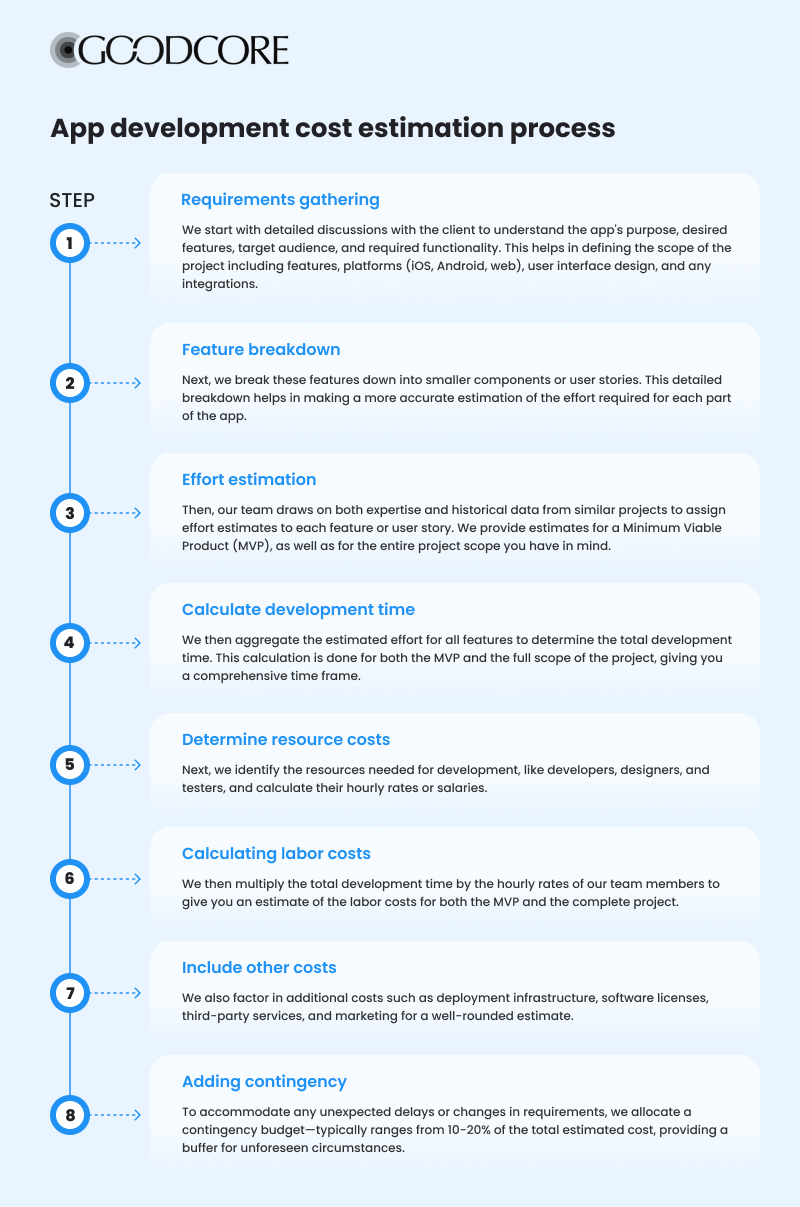
Key factors that influence app development costs
To accurately estimate the cost of developing an app, it’s crucial to first understand the factors that influence it. By understanding these cost-affecting factors, you can determine an approximate cost estimate for your app, setting a clear financial framework for your project.
Let’s take a look at the major factors that affect the overall cost of mobile application development.
Platform strategy
The choice of app platform is a critical factor that affects the mobile app development cost. The platform strategy depends heavily on your business goals, target audience’s needs, technical requirements, and resource constraints.
Essentially, you need to decide whether to build your app for iOS, Android, or both, and this decision has a direct impact on the cost to develop an app.
- Native development: Native apps are built for one platform using specific languages and tools (like Swift for iOS and Kotlin for Android). They offer the best performance and user experience but developing separate native apps for iOS and Android doubles the work, as each requires a distinct codebase. This results in higher costs.
- Cross-platform development: Cross-platform development involves frameworks like React Native, Flutter, or Xamarin that allow developers to write code once and deploy it on both iOS and Android. This approach is generally 20% to 50% faster than native development due to the ability to reuse code across multiple platforms. Cross-platform development might sometimes involve trade-offs in terms of performance and the ability to access native features compared to native apps.
- Hybrid app development: Hybrid apps are created using web technologies like HTML, CSS, and JavaScript and are wrapped in a native container. This approach leverages web technology which is generally faster and easier to develop with, potentially reducing costs. Hybrid apps can run on both iOS and Android platforms from a single codebase. However, they might not offer the same level of performance or integration with device features as native apps.
Apart from the choice of the app platform, also consider the following factors:
- Market considerations: Your target market is crucial in deciding the platform. iOS is popular in regions like North America and Europe, while Android has a broader reach globally. Understanding your audience’s preferred platforms can guide your decision in a more cost-effective direction.
- Platform-specific costs: The cost can vary depending on the platform-specific requirements. For instance, iOS apps might require adherence to stricter design guidelines, while Android apps have to be tested across a broader range of devices with varying screen sizes and hardware specifications, which can impact the testing phase.
App complexity and features
When it comes to mobile app development, the complexity of the app is a key factor that determines the number of hours needed for the project. Generally, the more complex and difficult the functionality, the longer it takes to implement it, as complexity affects not only the number of features but also team structure, database and backend needs, third-party tools, and integration choices.
In the table below, we’ve divided the apps into three levels of complexity and outlined how they affect the cost.
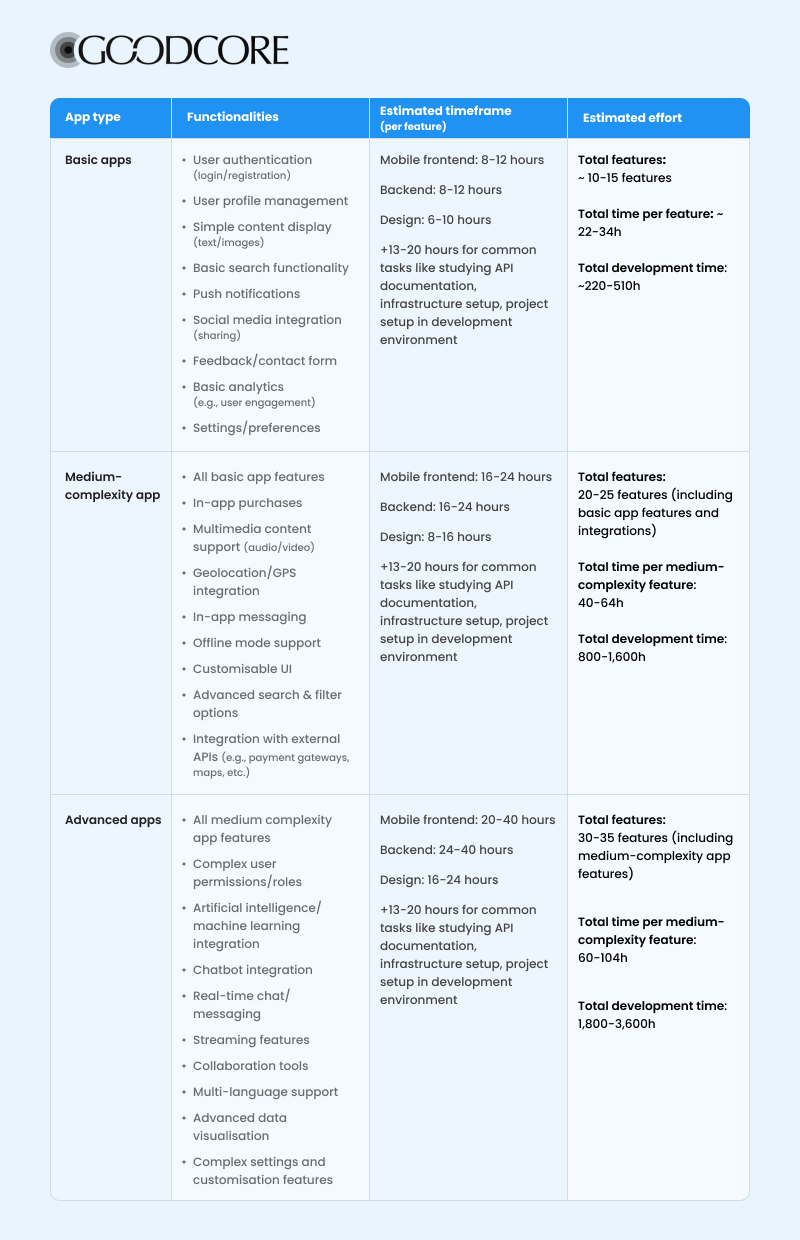
To manage this aspect of app complexity and features effectively, at GoodCore, we recommend a phased approach such as developing a Minimum Viable Product (MVP) first.
Starting with an MVP allows you to launch with essential features and then progressively scale the product based on user feedback and business needs. This approach not only helps validate your app idea with minimal risk but also spreads the development costs over time as you enhance and expand the app’s functionality.
Mobile app category and app feature complexity
As different app categories come with varying levels of complexity, features, user experience design, security needs, and backend infrastructure requirements, we’ve prepared a table to show you some specific examples of mobile apps, alongside their complexity levels and cost influencers:
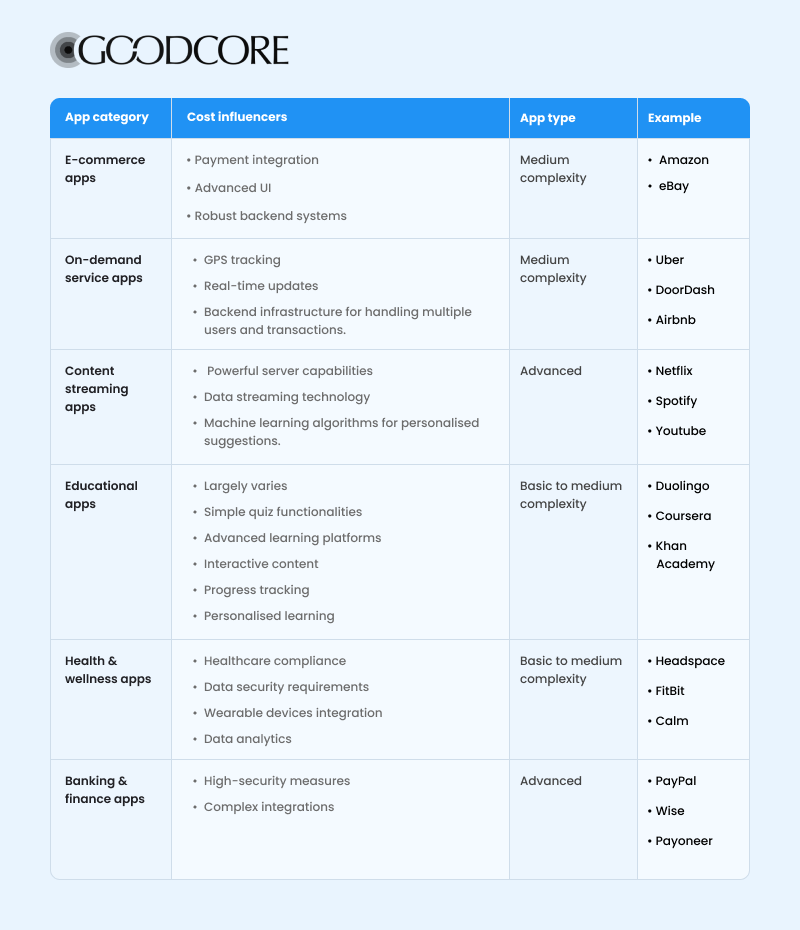
App design and animations
Another important element that impacts the overall development cost is your app’s design complexity.
For example, some app designs might require advanced features like real-time collaboration, voice interaction, or custom UI elements and animations to enhance the overall customer experience.
Such intricate, custom designs require more detailed wireframes, prototypes, and iterations. This extends the development timeline and increases the hours billed. In other words, projects with complex designs might require a larger portion of the budget to be allocated to the design phase.
Here are also some additional factors to consider while conceptualising complex designs for your app:
- Advanced tools: Sophisticated designs may require more advanced and possibly more expensive design and prototyping tools. These tools could be specialised software for high-fidelity mockups, animation, or interactive UX elements that are costlier to license.
- Usability testing: Complex designs often necessitate extensive usability testing to ensure the interface is user-friendly and intuitive. This process can uncover usability issues that may require multiple iterations of redesign, each adding to the overall project cost.
- Compatibility testing: Ensuring the app works seamlessly across various devices and platforms (iOS, Android, different screen sizes, etc.) can be more challenging with complex designs. This requires additional rounds of testing and subsequent tweaks to maintain design integrity and functionality.
- Scalability: Complex designs might be harder to scale or update when the app needs to evolve with new features or adjustments based on user feedback. Making changes to a sophisticated design can be more labour-intensive and costly than altering a simpler one.
- Technical debt: Overly complex designs can lead to technical debt if they are not well-implemented. This might mean that future updates take longer and cost more as developers need to work through the accumulated complexities of the original design.
Additionally, in the process of app design, the level of preparedness on the client’s side significantly influences the development timeline and cost. If you provide detailed design references and competitor analysis results upfront, it enables our design team to work more efficiently and effectively.
However, if these resources are not readily available, our team will need to invest additional time in market and user research and creating user personas and user journey maps. Thus, having these elements prepared beforehand can streamline the design process and help manage costs more effectively.
Structure and location of the development team
The influence of development resources—both technical and business specialists—on the cost of a mobile app development project is significant and multifaceted. Each type of resource contributes in distinct ways, affecting the overall project cost from start to finish.
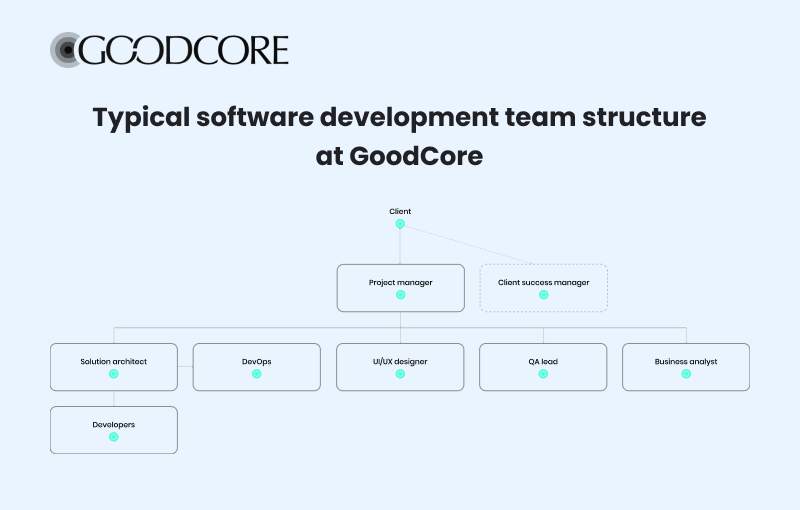
Technical specialists
Mobile app developers: The primary contributors to development costs are the software developers and engineers who write the app’s code. For example, the choice of technology (e.g., native vs. cross-platform development) affects the type of developers needed and can influence the development time and resources required. Additionally, highly skilled developers may command higher salaries, but their ability to work more efficiently and with fewer errors can reduce the need for extensive revisions and bug fixes.
UI/UX designers: The designers create the app’s interface and user experience. Similar to mobile app engineers, their expertise in managing the complexity of visual designs and custom animations directly impacts labour costs.
Architects and technical leads: These roles are responsible for the technical design and system architecture. Effective leadership ensures a robust app foundation, reducing the need for costly future modifications due to poor initial planning.
DevOps engineers: This role manages the technical processes and tools necessary for efficient app deployment and operation. They ensure seamless updates, minimal downtime, and robust system performance.
Business specialists
While technical resources are fundamental to building a mobile application, the role of non-technical team members in ensuring a project’s success is equally crucial. Integrating roles such as project managers, quality assurance, and business analysts represents not just an added cost but a strategic investment. Let’s explore the time and effort required for these activities:
Business analysts: Utilise 5-7% of development time to align the app with market and business needs, thereby avoiding costly post-launch adjustments and ensuring commercial viability.
Project managers: Account for about 10% of total development time, orchestrating the project to ensure it stays on schedule and within budget, thus preventing costly delays and scope creep.
QA experts: Constitute 10-12% of development time. Their early testing across different stages and platforms minimises post-launch costs by catching bugs early.
Hiring freelance developers vs. engaging an outsourced team
When it comes to finding and hiring development resources, you generally have two options: hiring freelancers or engaging with an outsourced development team.
So how much does it cost to develop an app by hiring freelancers? If you go the freelancer route, you’re looking at possibly more budget-friendly rates.
As discussed before, you might need a multifaceted technical team to deliver the mobile front-end and the backend of your application working on both the app’s code and interface.
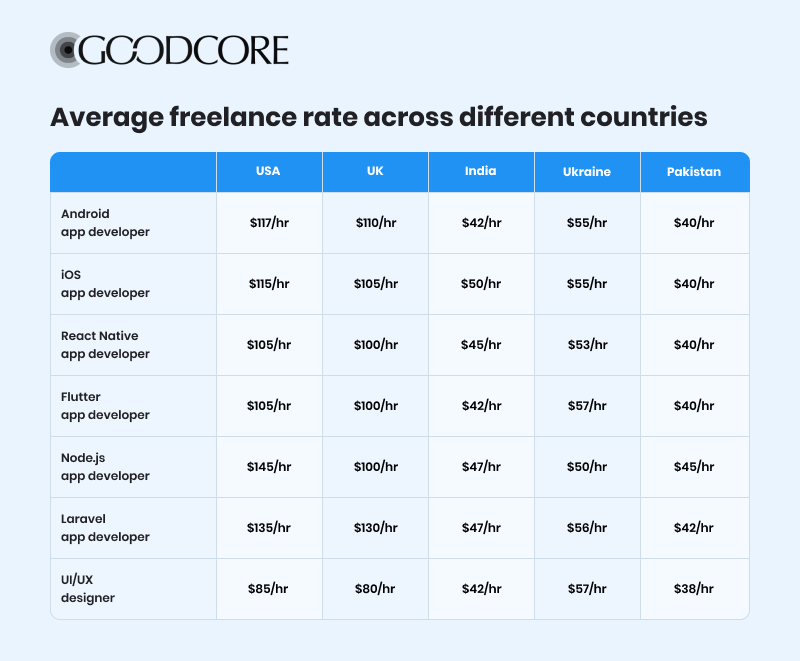
However, this approach requires investing time in hiring and managing diverse professionals, such as developers, designers, and QA specialists. The process is time-consuming and requires a solid understanding of what each role entails. Plus, you will have to take on the business analysis and project management roles yourself. Without adequate business skills, this can lead to inflating your budget and timeline.
With an outsourced team, you get all the required resources in one package. This also includes business analysts, project managers, and QA specialists as value-added roles within a fixed-cost engagement. It saves you the hassle of hiring different professionals for various roles. You only need to communicate your business and functional requirements, and the outsourced team takes care of the rest. However, outsourcing has its challenges, such as selecting the right provider, ensuring effective communication, and managing time zone differences.
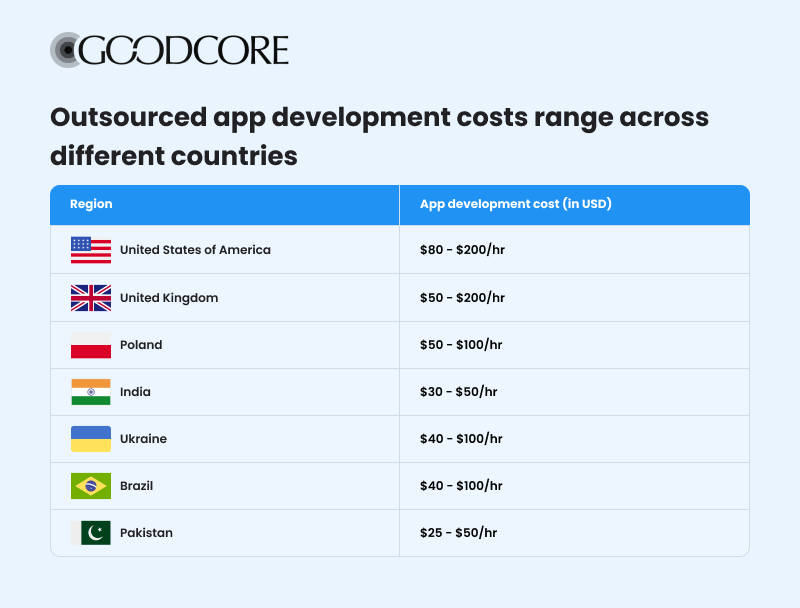
Speaking of selecting the right provider, you may want to check out our guide: What is SoW in Software Development and How To Evaluate Your Future Provider Based on Their Statement of Work
In short, when it comes to mobile app development cost, each option has its pros and cons. Your choice will depend on your budget, project complexity, and management capacity.
Additional costs
Apart from the development cost to build an app, there are some additional costs that you might not have thought of but they impact the budget overall. We’ve discussed them below.
App submission cost
While it’s not directly the cost to build an app, submitting an app to the app stores is not always straightforward. It involves preparing various assets (like app icons, screenshots, and descriptions), filling out detailed information, and potentially communicating with app store support teams in case of submission issues or rejections. The time and effort required for a successful submission can be significant and may incur additional costs.
It’s important to note that the collaboration model with your development team or service provider matters a lot in this regard.
| Time and materials model | Fixed price and fixed scope model |
| If you are working with a provider on a time and materials basis, the app submission process is likely to incur additional costs. This is because the time spent on making necessary adjustments and handling the submission process is counted as billable hours. | In a fixed-price model, the cost of the app submission process is included in the overall project price. Since the scope and price are agreed upon in advance, any work related to app submission is covered within this fixed cost, provided it falls within the agreed-upon project scope. |
Apart from that, there are some additional costs that you have to consider:
- App store fees: Both Google Play and Apple App Store charge fees for app submission – a one-time fee for Google Play and an annual fee for the Apple App Store.
- App store optimisation (ASO): You may want to collaborate with specialised ASO professionals to maximise your app’s reach in the app store search algorithms.
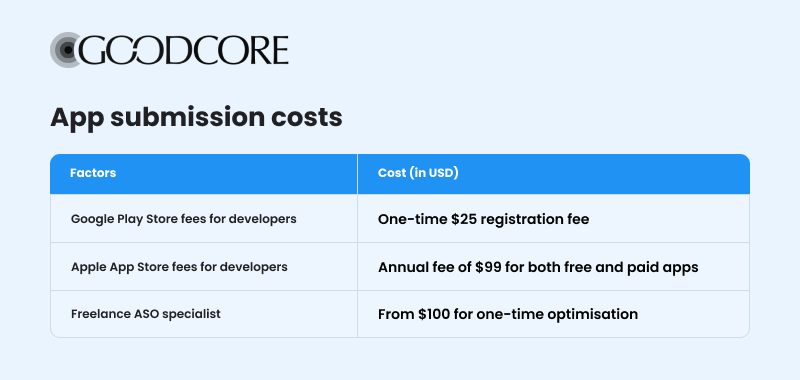
Marketing and legal cost
Marketing and legal aspects, while not development costs per se, are part of the overall budget needed and should be integrated into the budget planning from the early stages of the app development process.
Once your app is developed, you’ll need to promote it to reach your target audience. Depending on the scale and scope of your marketing plan, this can be a substantial part of your overall budget. Here are some marketing activities that you might need to budget for:
- Market research: Initial market research to understand the target audience, competitive landscape, and positioning of the app. While you can do it yourself, in some cases, you might need to hire a market research analyst.
- App store optimization (ASO): Optimising the app’s listing in app stores to improve visibility and ranking. You may want to collaborate with specialised ASO professionals to maximise your app’s reach in the search algorithms.
- Promotional activities: Advertising campaigns, social media marketing, influencer partnerships, and promotional content creation (videos, blogs, infographics) require additional budget.
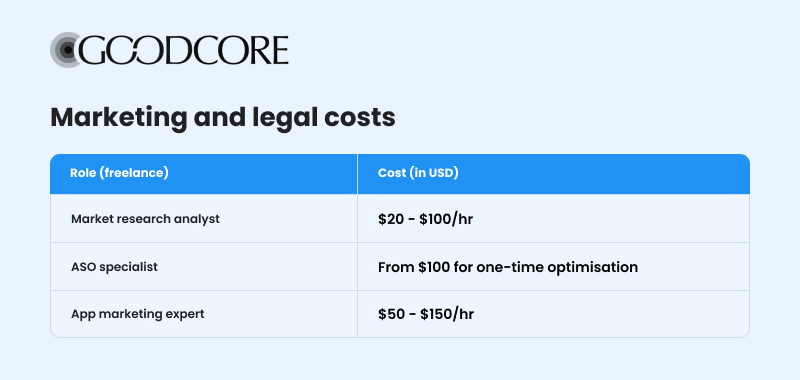
Legal considerations are also vital for some apps.
- Compliance with regulations: Ensuring the app complies with relevant laws and regulations (like GDPR for privacy, COPPA for children’s apps, or HIPAA for healthcare apps) can incur costs for legal consultation and potential modifications to the app’s functionality.
- Intellectual property (IP) protection: Costs for protecting the app’s intellectual property, including trademarks for the app name and logo, and patenting unique features or methodologies.
- Privacy policy and terms of use: Drafting comprehensive privacy policies and terms of use agreements, preferably with legal expertise, to ensure clarity and compliance with legal standards.
Post-launch operational costs
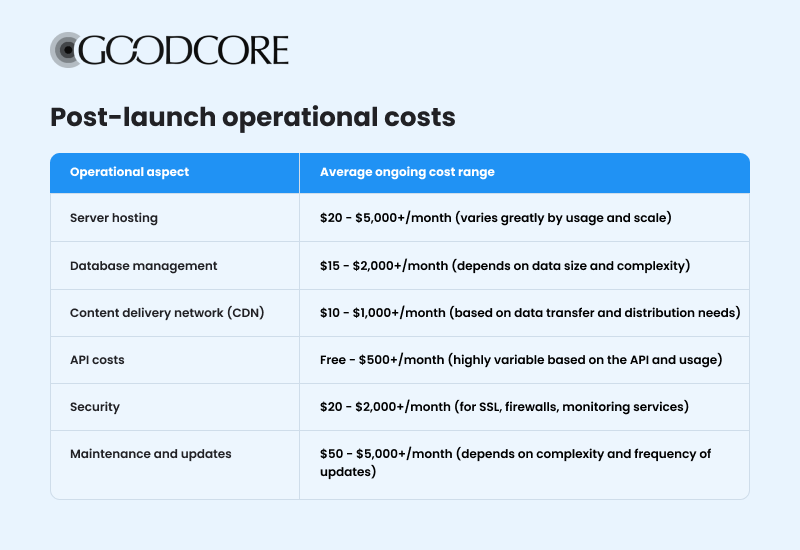
Once your app is developed and is live on the app store, it’s not the end of the story. There are some ongoing costs required to keep your app running smoothly after launch. These costs are recurring, so it’s important to factor them into your long-term budget.
Server hosting
Your app might require dedicated servers or cloud services for hosting. Prices vary based on the server’s capacity, scalability, and whether you opt for physical servers or cloud-based services like AWS (Amazon Web Services) or Microsoft Azure.
For apps requiring dedicated servers, costs include not just leasing the server hardware but also maintaining and securing them.
Database management
If your app handles a lot of user data, you’ll need robust database management services. The cost of database storage solutions, whether cloud-based or on-premises, varies based on the size and type of data stored.
Regular backups and having a robust recovery plan in place are essential, especially for data-intensive apps. These also add to the operational costs.
Content delivery network (CDN)
For apps that serve users globally, a CDN can improve loading times and user experience. CDNs distribute your app’s content across multiple geographical locations, but they add to the infrastructure cost. The cost depends on the amount of data transferred and the geographic coverage required.
API and third-party services
If your app uses third-party APIs (like maps, payment gateways, social media integration), there might be recurring costs based on the level of usage.
Security
Security is a recurring cost, vital for maintaining user trust and data integrity. Ongoing security measures include regular updates, SSL certificates, compliance with data protection laws, and proactive threat detection systems.
Maintenance and updates
Regular software updates, bug fixes, and performance improvements are essential for the app’s smooth operation. The best way to go about this is to engage your service provider for application maintenance and support services at a fair additional cost.
You might have noticed the broad range in the operational costs presented in the above table. This is because of the diversity in the app’s scale, complexity, and user base. Smaller, simpler apps demand less ongoing costs, while large, complex apps with extensive features and a vast user base require more expensive operational costs. Additionally, specific technology choices for each app further contribute to this broad cost spectrum.
In wrapping up, there’s no one-size-fits-all answer to how much does it cost to build an app. It varies, influenced by numerous factors as discussed above. However, by considering all these elements, you can arrive at a rough cost estimate for your app. If you’re looking for a more specific figure, our expert team at GoodCore Software is here to help. Consult with us to get a nearly accurate estimate tailored to your business needs and take the first step towards starting your mobile app development project.
Need an estimation for your app idea? Get a free quote from our expert team
FAQs
How much does it cost to create an app?
Although, it’s impossible to provide an accurate estimate without a thorough understanding of the specific requirements, here are estimated costs:
Simple apps: $10,000 – $25,000
Medium complexity apps: $40,000 – $80,000
Advanced apps: $170,000 – $200,000
How long does it take to develop an app?
App development timelines can vary greatly depending on the app’s complexity and features. A simple app with basic functionality might take a few weeks to a couple of months to develop, whereas more complex apps with advanced features and custom designs can take anywhere from six months to over a year. Factors like the structure of the development team and the chosen platform(s) also play a significant role in determining the overall timeline.
What are the factors that influence the cost of building an app?
How much does it cost to create an app depends on several key factors, including the app’s complexity and features, its design and user interface, the choice of development platforms (iOS, Android, or both), the structure and location of the development team, additional costs like marketing, legal, and operational expenses. Each factor adds varying degrees of complexity and resource requirements, significantly impacting the overall cost of an app development.
How much does it cost to maintain an app?
The cost to maintain an app generally ranges from 15% to 20% of its original development cost annually. This includes updates to keep the app compatible with the latest OS versions, bug fixes, performance enhancements, monitoring server costs, and potentially adding new features.
What are the hidden costs in app development that businesses should be aware of?
In app development, some hidden costs that you should be aware of include ongoing maintenance and updates, backend server costs (if not included in initial estimates), third-party service integrations (like payment gateways), data storage fees, and unexpected expenses in meeting legal and compliance standards. Additionally, costs related to app submission and app marketing often go overlooked in initial budgeting. These hidden costs can significantly impact the overall budget if not planned for in advance.
How does monetisation strategy influence the cost of developing an app?
Your app’s monetisation strategy significantly influences its development cost. Features like in-app purchases, subscriptions, or ad integration require additional development work for payment systems, secure transaction processing, and partnerships with payment gateways or ad networks. Therefore, it’s important to factor in these aspects when estimating the overall app development cost.
How does legacy application modernization impact app development costs?
Modernizing legacy applications can significantly influence the overall costs of app development. By upgrading outdated software, businesses can enhance performance, streamline integration processes, and ensure better security, which may initially increase costs but ultimately leads to substantial savings. Modernization reduces maintenance expenses and downtime, avoiding the higher costs associated with supporting older, less efficient systems. This makes it a crucial consideration for cost-effective, long-term app management and development strategies.





